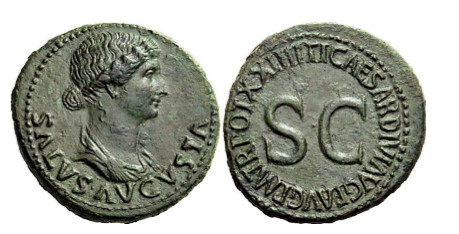
PREV ARTICLE
NEXT ARTICLE
FULL ISSUE
PREV FULL ISSUE
WOMEN ON ANCIENT COINS
Mike Markowitz published a nice article for CoinWeek on women on ancient coins. Here's a short excerpt; be sure to read the complete article online.
-Editor
Much like Americans, Republican Romans had a deep-rooted prejudice against depicting living people on their money. It was something that pretentious Greek kings and tyrants did. When Julius Caesar violated this taboo, his assassins claimed that he was trying to make himself a king. And yet, within a few years, Brutus struck his own portrait on coins to pay his army – the famous “Ides of March” denarius. The civil wars that tore the Republic apart (49-30 BCE) saw dramatic social change, including changes in gender roles. Female figures had appeared on Roman coinage for centuries, but these were goddesses, personifications, or legendary figures like the Vestal Virgin Tarpeia, who appeared on a denarius in 89 BCE. Written by men, Roman history reflects the values of a rigidly patriarchal society. But all those men had mothers, and most had sisters, wives, and daughters. These women are mostly invisible; we hear their voices only in brief passages men thought it appropriate–or politically correct–to record. Coins are one place where a few elite women show their faces. With some imagination (and much digging through books), we can try to recover their stories. Formidable Fulvia 
Born about 83 BCE, Fulvia Flacca Bambula married three powerful politicians who all died violently. In the civil war that followed Caesar’s assassination, Fulvia found herself in charge of Italy as the men went off to build empires and fight in the East. This brought her into conflict with Octavian, Antony’s rival for power. Around this time, the Roman mint at Lugdunum (now Lyon, France) struck silver coins depicting the goddess of Victory with the features of Fulvia. She became the first living Roman woman to appear on a coin. Octavia the Younger, Sister of Augustus 
Born in 69 BCE, Octavia was the daughter of a Roman senator and Atia Balbia Caesonia, Julius Caesar’s niece. She was the older sister of Octavian (born 63 BCE – Roman families were stubbornly consistent about personal names). Despite her beauty and strong character, Octavia lost the competition for Antony’s heart to the Queen of Egypt. Livia Drusilla 
Livia’s portrait, never explicitly identified by an inscription, appears on the coinage of Tiberius. On the reverse of the denarius, she sits enthroned as Pax, the personification of peace, holding an olive branch. On some dupondii, she is identified as SALVS, or Salus (“welfare” or “safety”). Livia was the first Roman woman granted the title of Augusta (empress).
To read the complete article, see:
Ancient Coin Insights: Real Roman Women on Coins
(www.coinweek.com/featured-news/ancient-coin-roman-women-on-coins/)
The Numismatic Bibliomania Society is a non-profit organization promoting numismatic literature. See our web site at coinbooks.org. To submit items for publication in The E-Sylum, write to the Editor at this address: whomren@gmail.com To subscribe go to: https://my.binhost.com/lists/listinfo/esylum All Rights Reserved. NBS Home Page Contact the NBS webmaster 
|